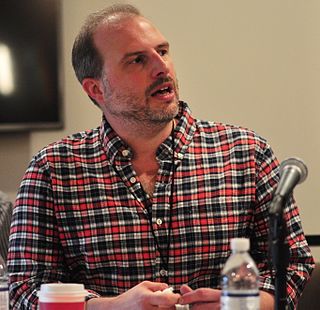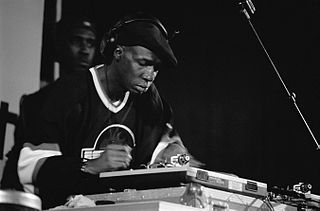French hip hop or French rap, is the hip hop music style developed in French-speaking countries. France is the second largest hip-hop market in the world after the United States.
Japanese hip hop is hip hop music from Japan. It is said to have begun when Hiroshi Fujiwara returned to Japan and started playing hip hop records in the early 1980s. Japanese hip hop tends to be most directly influenced by old school hip hop, taking from the era's catchy beats, dance culture and overall fun and carefree nature and incorporating it into their music. As a result, hip hop stands as one of the most commercially viable mainstream music genres in Japan and the line between it and pop music is frequently blurred.
East Coast hip-hop is a regional subgenre of hip-hop music that originated in New York City during the 1970s. Hip-hop is recognized to have originated and evolved first in The Bronx, New York City.
Southern hip hop, also known as Southern rap, South Coast hip hop, or dirty south, is a blanket term for a regional genre of American hip hop music that emerged in the Southern United States, especially in Georgia, Texas, Louisiana, Tennessee, and Florida—often titled "The Big 5," five states which constitute the "Southern Network" in rap music.
Hip hop music has been popular in Africa since the early 1980s due to widespread African American influence. In 1985, hip hop reached Senegal, a French-speaking country in West Africa. Some of the first Senegalese rappers were Munyaradzi Nhidza Lida, M.C. Solaar, and Positive Black Soul.
Christian hip hop is a cross-genre of contemporary Christian music and hip hop music. It emerged from urban contemporary music and Christian media in the United States during the 1980s.
Hardcore hip hop is a subgenre of hip hop music that developed through the East Coast hip hop scene in the 1980s. Pioneered by such artists as Run-DMC, Schoolly D, Boogie Down Productions and Public Enemy, it is generally characterized by anger, aggression and confrontation.
Underground hip-hop is an umbrella term for hip hop music that is outside the general commercial canon. It is typically associated with independent artists, signed to independent labels or no label at all. Underground hip hop is often characterized by socially conscious, positive, or anti-commercial lyrics. However, there is no unifying or universal theme – AllMusic suggests that it "has no sonic signifiers". "The Underground" also refers to the community of musicians, fans and others that support non-commercial, or independent music. Music scenes with strong ties to underground hip hop include alternative hip hop and conscious hip hop. Many artists who are considered "underground" today were not always so, and may have previously broken the Billboard charts.
Native American Hip Hop is hip hop culture practiced by people of Native American heritage, including Canadian First Nation hip hop artists. It is not a specific form of hip hop but varies in style along the lines of hip hop in general. Native Americans have been present in hip hop culture since its inception as breakdancers, DJs, rappers, and graffiti artists. The Native American contribution to hip hop can occasionally be veiled by the ethnic umbrella term of Hispanic or Latino, terms that may refer to Native Americans in certain contexts.

Stephen Thomas Erlewine is an American music critic and former senior editor for the online music database AllMusic. He is the author of multiple artist biographies and record reviews for AllMusic, as well as a freelance writer, occasionally contributing liner notes.

Hip hop or hip-hop is a culture and art movement that was created by African Americans, and Caribbean Americans starting in the Bronx, New York City. Pioneered from Black and Caribbean American street culture, that had been around for years prior to its more mainstream discovery.. Hip-hop culture has historically been shaped and dominated by African American men, though female hip hop artists have contributed to the art form and culture as well. Hip hop culture is characterized by the key elements of rapping, DJing and turntablism, and breakdancing; other elements include graffiti, beatboxing, street entrepreneurship, hip hop language, and hip hop fashion. From hip hop culture emerged a new genre of popular music, hip hop music.

Hip hop production is the creation of hip hop music in a recording studio. While the term encompasses all aspects of hip hop music creation, including recording the rapping of an MC, a turntablist or DJ providing a beat, playing samples and "scratching" using record players and the creation of a rhythmic backing track, using a drum machine or sequencer, it is most commonly used to refer to recording the instrumental, non-lyrical and non-vocal aspects of hip hop.

Political hip hop is a subgenre of hip hop music that emerged in the 1980s as a form of political expression and activism. It typically addresses sociopolitical issues through lyrics, aiming to inspire action, promote social change, or convey specific political viewpoints. The genre draws inspiration from earlier politically conscious artists, such as The Last Poets and Gil Scott-Heron, as well as movements like the Black Power movement and the Black Panther Party from the 1960s and 1970s.
Twin Cities hip hop, also referred to as Minneapolis hip hop, is sub-genre of rap music that originates from the Minneapolis–Saint Paul metropolitan area in the U.S. state of Minnesota.
Hip-hop or hip hop, formerly known as disco rap, is a genre of popular music, that emerged in the late 1960s and early 1970s primarily from African American, Afro-Latin, and Afro-Caribbean musical aesthetics practiced by youth in the South Bronx. Hip-hop music originated as an anti-drug and anti-violence social movement led by the Afrika Bambaataa and the Universal Zulu Nation. The genre is characterized by stylized rhythmic sounds—often built around disco grooves, electronic drum beats, and rapping, a percussive vocal delivery of rhymed poetic speech as consciousness-raising expression. The music developed as part of the broader hip-hop culture, a subculture defined by four key stylistic elements: MCing/rapping, DJing/scratching with turntables, breakdancing, and graffiti art or writing. Knowledge is sometimes described as a fifth element, underscoring its role in shaping the values and promoting empowerment and consciousness-raising through music. In 1999, emcee KRS-One, often referred to as "The Teacher," elaborated on this framework in a Harvard lecture, identifying additional elements that extend beyond the basic four. These include self-expression, street fashion, street language, street knowledge, and street entrepreneurialism, which remain integral to hip-hop's musical expression, entertainment business, and sound production. Girls’ double-dutch was also recognized as a key stylistic component of breakdancing, according to KRS. While often used to refer solely to rapping and rap music, "hip-hop" more properly denotes the practice(s) of the entire subculture. The term hip-hop music is sometimes used synonymously with the term rap music, though rapping may not be the focus of hip-hop music. The genre also centers DJing, turntablism, scratching, beatboxing, and instrumental tracks.
Alternative hip hop is a subgenre of hip hop music that encompasses a wide range of styles that are not typically identified as mainstream. AllMusic defines it as comprising "hip hop groups that refuse to conform to any of the traditional stereotypes of rap, such as gangsta, bass, hardcore, and party rap. Instead, they blur genres drawing equally from funk and pop/rock, as well as jazz, soul, reggae, and even folk."
Hip hop feminism is a sub-set of black feminism that centers on intersectional subject positions involving race and gender in a way that acknowledges the contradictions in being a black feminist, such as black women's enjoyment in hip hop music and culture, rather than simply focusing on the victimization of black women in hip hop culture due to interlocking systems of oppressions involving race, class, and gender.

Run-DMC was an American hip hop group from Hollis, Queens, New York City, formed in 1983 by Joseph Simmons, Darryl McDaniels, and Jason Mizell. Run-DMC is regarded as one of the most influential acts in the history of hip hop culture and especially one of the most famous hip hop acts of the 1980s. Along with Beastie Boys, LL Cool J, DJ Jazzy Jeff & the Fresh Prince, and Public Enemy, the group pioneered new-school hip hop music and helped usher in the golden age of hip hop. The group was among the first to highlight the importance of the MC and DJ relationship.
Jewish hip hop is a genre of hip hop music with thematic, stylistic, or cultural ties to Judaism and its musical traditions.